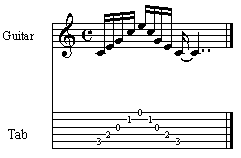- Home
- Classical Fingerstyle Portal
- 15 Actionable Guitar Lessons
- Classical Guitar Technique
- Guitar Lessons
- Beginner Lessons
- Guitar History
- The Renaissance Guitar
- Guitar Time Line
- Classical Guitar Blog
- Contact
- About Author
- Site Search
- Privacy Policy
- Site Map
- Classical Guitar Study Course 3.0
- Instant Classical Guitar Repertoire
- Classical Guitar Lessons For Beginners
Guitar Arpeggio
Playing the arpeggio, also known as a 'broken chord', is not that difficult if you followa proven method of procedure that has stood the test of time. You'll find this technique occurs often in many guitar lessons.
A common way to perform an arpeggio is to begin with the thumb and then the fingers (used in succession from index to ring finger). It can have many different finger combinations.
Indeed, it is one of the more frequently used items in the 'finger-style guitar arsenal'.
Mauro Giuliani was certainly convinced of their practical use back in the 18th and 19th centuries.
He wrote 120 of them using just two chords, namely, C and G7. In his excellent resource, Pumping Nylon for the Classical Guitar, Scott Tennant says of these:
"This group of studies is the best and most comprehensive collection of these formulas I have seen."
Indeed, Giuliani himself said...
"If one could play all of these studies well, one could successfully play anything I ever wrote."
To add weight to this opinion I quote the famous guitar pedagogue, Frederick M. Noad, who said...
"They serve to develop a balanced and even touch in the fingers of the right hand."
Mostly, it is played with free stroke, and they give a rippling effect by playing notes in succession rather than in 'block harmony'.
When I'm teaching students, I like to get them to imagine a chord from the bass upwards in block harmony being pulled sideways. That is, stretching the chord out from left to right across the page from bottom to top.
This has the effect of making them see a clearer distinction between a broken chord and a block chord. I even get them to play these two types of chords one after the other to reinforce the difference.
That's when the "aha!" factor comes into effect. It is easy to do with a C chord if your student is indeed able to finger chords correctly.
Here is a graphic representation of what I get my student to play after he or she has mentally practiced 'stretching' the chord...
Once you get used to playing this technique it is wise to play several times backward and forward or up and down if you like.
This creates a continuous cycle and helps to create if practised slowly at first, the "balanced and even touch" of which Fred Noad was talking.
Seriously though, perfecting this technique is to your guitar playing as what eating vegetables are for the health of your body...VITAL!
It doesn't matter what style of guitar you play. We can all benefit from a little finger style guitar that involves some some of these guitar techniques.
Benefits of learning to play an arpeggio on classical guitar...
Learning arpeggios on the classical guitar offers several benefits to guitarists, both technically and musically. Here are some of the advantages of incorporating arpeggios into your classical guitar practice:
- Finger Independence and Dexterity: Arpeggios involve playing individual notes of a chord in a specific order. Practicing arpeggios helps develop finger independence, allowing you to control each finger individually and improve overall dexterity. This enhances your ability to play complex passages and execute intricate fingerings.
- Right Hand Technique: Arpeggios are an excellent way to refine your right-hand technique, particularly fingerpicking or classical guitar-specific techniques like rest stroke and free stroke. They help you develop consistent and controlled finger movements, precise string articulation, and the ability to balance the volume between different fingers.
- Chord Knowledge: Arpeggios provide a deeper understanding of chords. By playing the individual notes of a chord separately, you become more familiar with the chord structure, intervals, and harmonic relationships. This knowledge can be applied to improvisation, composition, and better interpretation of musical pieces.
- Rhythmic Precision: Practicing arpeggios helps you improve your rhythmic accuracy. Arpeggios often involve various rhythmic patterns, which can challenge your timing skills. Consistent practice of arpeggios enhances your sense of timing, rhythm, and overall musicality.
- Fingerboard Familiarity: Arpeggios require you to navigate the guitar fretboard efficiently. By practicing arpeggios in different keys and positions, you become more comfortable with the instrument's layout. This familiarity translates into improved fretboard visualization, allowing you to find chords, scales, and melodies more easily.
- Musical Expressiveness: Arpeggios can add richness and texture to your playing. They enable you to highlight individual chord tones, create melodic lines within chords, and add variations to chord progressions. By incorporating arpeggios into your musical vocabulary, you can enhance your expressiveness and phrasing as a guitarist.
- Repertoire Expansion: Many classical guitar compositions incorporate arpeggios extensively. By mastering arpeggios, you gain access to a broader range of repertoire and can effectively tackle pieces that utilize arpeggio-based techniques. This opens up opportunities for you to explore classical guitar literature and diversify your performance repertoire.
Overall, learning arpeggios on the classical guitar strengthens your technical abilities, deepens your understanding of harmony, and enhances your musical expression. By incorporating arpeggios into your regular practice routine, you can unlock new creative possibilities and become a more versatile and accomplished guitarist.
Carcassi Arpeggio Study...
Here's a little video to highlight this arpeggio technique by Carcassi. It's around the Intermediate level so if you aren't up to playing it yet, you can practice easier ones in my Guitar-Fingerstyle Portal (see link under the Carcassi Arpeggio PDF below),,,

For more practice of playing an arpeggio go here...
https://www.learnclassicalguitar.com/Classical-Guitar-Fingerstyle-Portal
To learn more about the arpeggio go here...
Arpeggio Page - Frequently Asked Questions
1. What is an arpeggio on the guitar?
1. What is an arpeggio on the guitar?
An arpeggio is when you play the notes of a chord one after another instead of strumming them together. It’s also called a “broken chord.”
2. Why are arpeggios important for classical guitar?
2. Why are arpeggios important for classical guitar?
Arpeggios develop finger independence, dexterity, and right-hand technique. They are used in many classical guitar pieces and help create a smooth, rippling sound.
3. How do you play a basic arpeggio on guitar?
3. How do you play a basic arpeggio on guitar?
A common method is to pluck with the thumb followed by the index, middle, and ring fingers. Many practice patterns are based on this sequence.
4. Who wrote the famous 120 arpeggio studies for guitar?
4. Who wrote the famous 120 arpeggio studies for guitar?
The 18th–19th century guitarist Mauro Giuliani composed 120 arpeggio studies, still widely used today to train finger technique and coordination.
5. What’s the difference between a broken chord and a block chord?
5. What’s the difference between a broken chord and a block chord?
A block chord plays all notes together, while a broken chord (arpeggio) stretches them out in sequence one after the other, producing a flowing, melodic effect.
6. Should I practice arpeggios with rest stroke or free stroke?
6. Should I practice arpeggios with rest stroke or free stroke?
Most classical guitarists play arpeggios with free stroke for a smooth sound, but practicing both helps improve technique. I much prefer tirando myself!
7. What are the benefits of practicing arpeggios daily?
7. What are the benefits of practicing arpeggios daily?
Daily arpeggio practice improves rhythm, coordination, and right-hand balance. It also strengthens your fingers and prepares you for advanced repertoire.
Recent New Pages:

